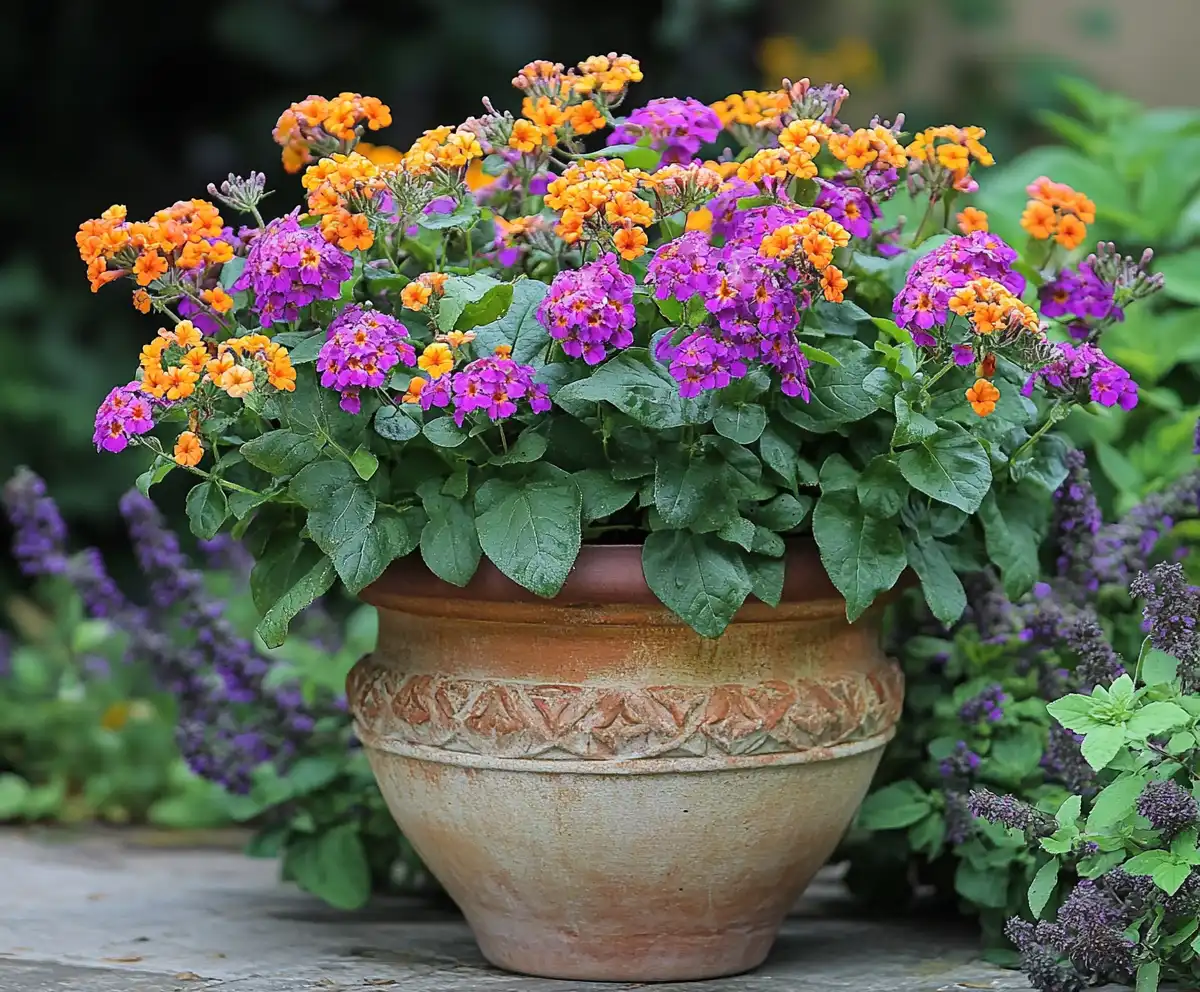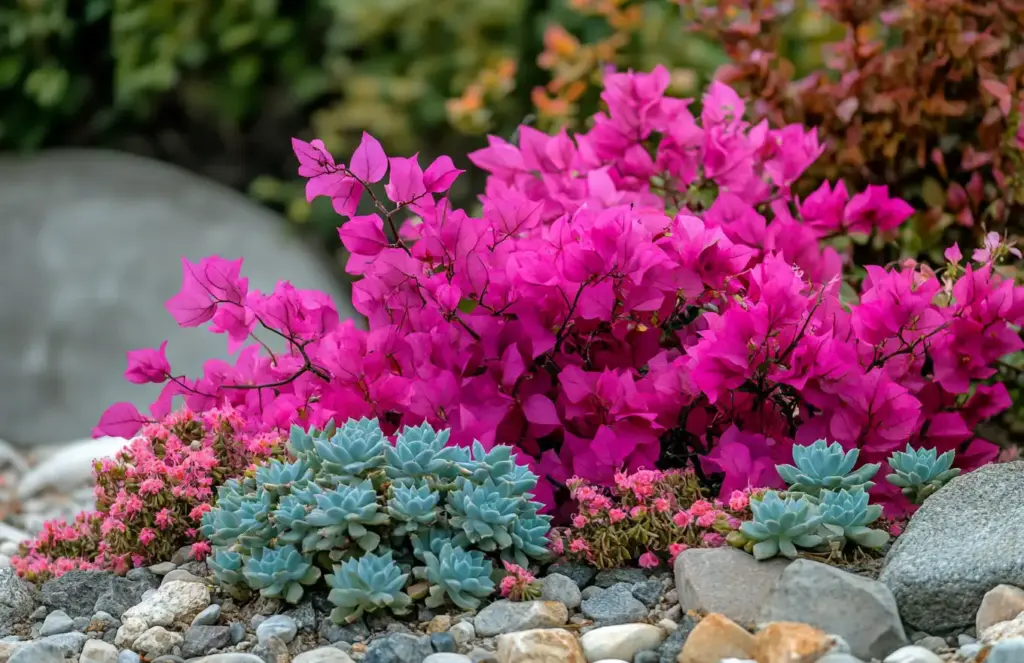Drought tolerant plants are a gardener’s secret weapon for thriving in dry, arid conditions
These resilient beauties are specially adapted to survive with minimal water , making them perfect for regions with hot climates or water restrictions
Whether you’re looking to add color to your garden or create a low-maintenance landscape , incorporating drought tolerant plants can help you achieve lush greenery without the constant need for irrigation. In this article, we’ll explore the top 10 drought tolerant plants , each offering unique characteristics and beauty that make them stand out even in the harshest environments
🌿 Love gardening inspiration? Follow me on Pinterest for bold plant ideas, tips, and seasonal color!
Table of Contents
1. Bougainvillea
Bougainvillea is one of the most vibrant and hardy drought tolerant plants you can add to your garden. Known for its stunning, papery bracts in shades of pink, red, orange, and white, this thorny ornamental plant thrives in hot and dry climates. Originating from South America, bougainvillea is an easy-to-grow favorite that brings a splash of color to fences, walls, and trellises, even during long dry spells.
Growing Conditions:
- Soil: Prefers acidic, well-drained soil to prevent root rot.
- Location: Full sunlight is essential for optimal flowering.
- Temperature: Tolerates 30-40°F, but thrives in warm weather.
- Plant Height: Can grow anywhere from 1 to 12 meters, depending on variety and pruning.
- Colors: Available in vibrant pink, yellow, white, and orange hues.
- Fertilizers: Low-nitrogen fertilizers help maintain vibrant blooms without excessive leafy growth.
- Companion Plants: Consider pairing with plants like Flying Saucers, Georgia Blue, and Black Pearl for a stunning garden display.
Bougainvillea’s drought tolerance comes from its deep root system and ability to store water in its woody stems, making it an excellent choice for low-water gardens.
2. Portulaca
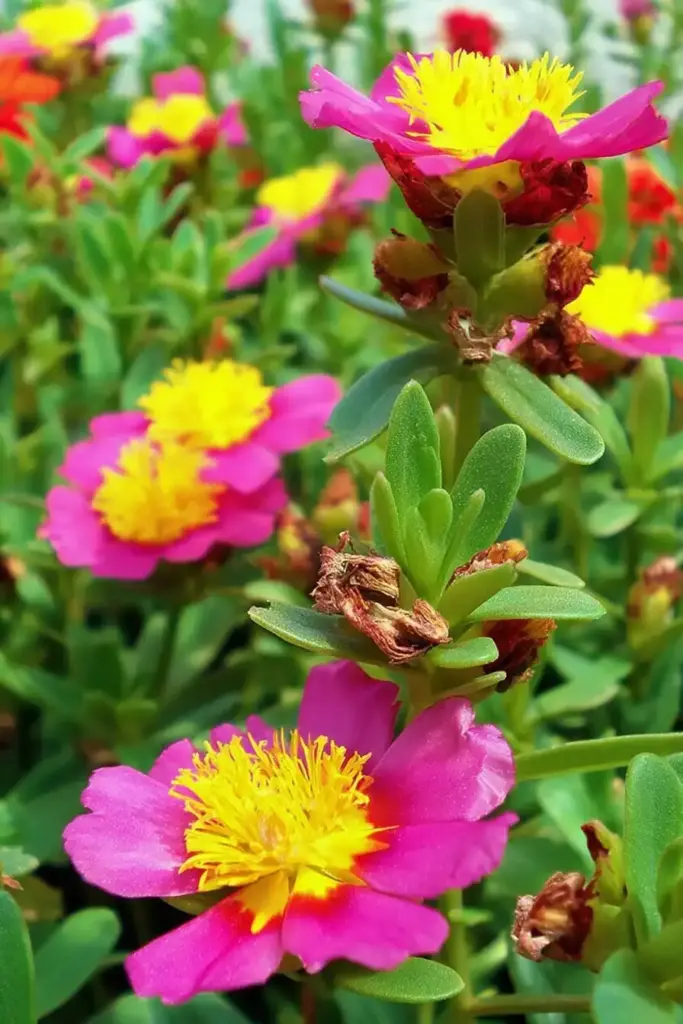
Portulaca, commonly known as moss rose, is a charming drought tolerant plant that thrives in hot, sunny conditions. Its vibrant, rose-like flowers in shades of pink, red, orange, and yellow add a delightful pop of color to rock gardens, containers, and borders. Thanks to its thick, succulent leaves, Portulaca stores water efficiently, allowing it to flourish even during prolonged dry spells.
Growing Conditions:
- Soil: Prefers dry, sandy soil with a pH of 5.5 to 6.0, ensuring excellent drainage.
- Location: Needs full sunlight to encourage profuse flowering.
- Temperature: Grows best in warm temperatures between 75-80°F.
- Plant Height: Typically reaches about 1 foot, making it perfect for ground cover.
- Colors: Blooms in brilliant pink, red, lavender, and orange shades.
- Fertilizers: Responds well to high-nitrogen and phosphorus fertilizers for enhanced blooms.
- Companion Plants: Combine with creeping zinnia, dusty miller, and globe amaranth for a vibrant garden tapestry.
Portulaca’s ability to thrive in rock gardens and its minimal water needs make it a favorite for gardeners seeking beauty without constant maintenance.
3. Lithops
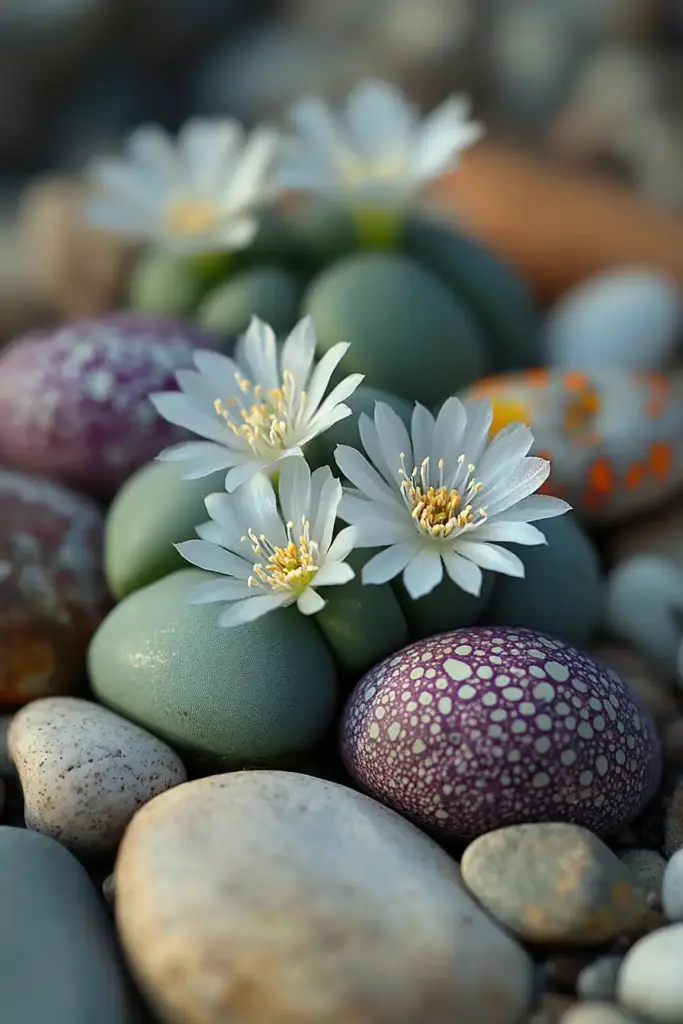
Lithops, also known as living stones or pebble plants, are among the most fascinating drought tolerant plants you can grow. These succulents are masters of disguise, mimicking the appearance of stones to protect themselves from herbivores. Their unique structure—fused, fleshy leaves with a hard, rock-like appearance—enables them to store water efficiently, making them ideal for arid gardens.
Growing Conditions:
- Soil: Requires soil with a pH above 7.0 for healthy growth.
- Location: Thrives in full sunlight, but ensure it’s protected from intense midday heat in very hot climates.
- Temperature: Can handle high temperatures up to 120°F.
- Plant Height: Typically grows between 0.5 and 1.5 feet tall, perfect for container gardening or rock gardens.
- Colors: Cream, gray, and brown hues enhance its stone-like appearance.
- Fertilizers: Use diluted cactus fertilizers sparingly to avoid over-fertilizing.
- Companion Plants: Pairs beautifully with other succulents like Pleiospilos and Echeveria.
Lithops are ideal for xeriscaping, requiring minimal care and offering a truly unique addition to any drought tolerant garden.
4. Blanket Flower
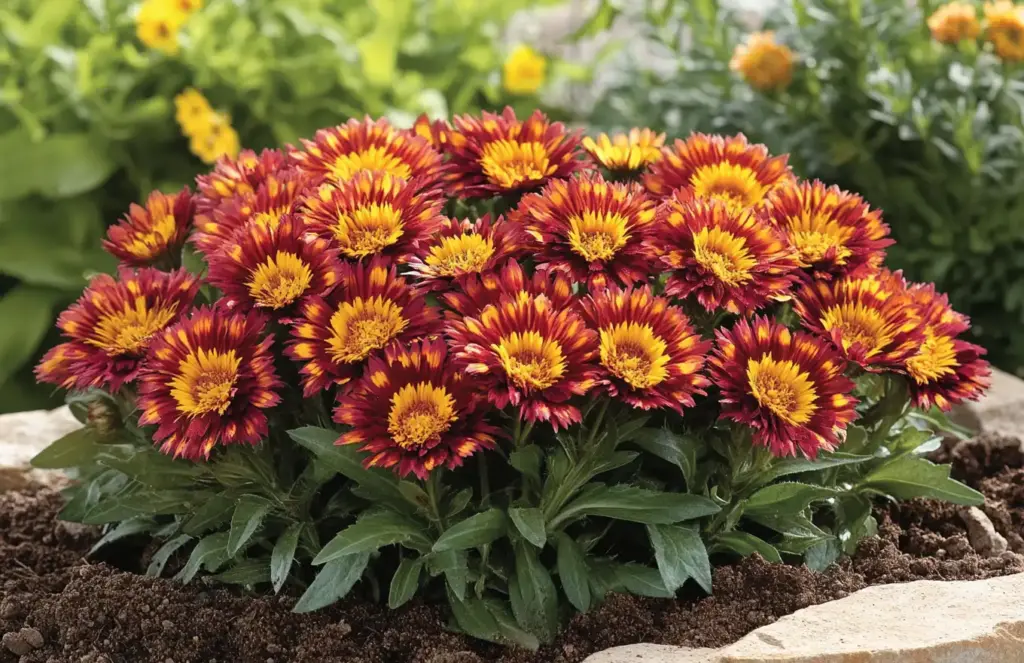
Blanket flower, also known by its botanical name Gaillardia, is a perennial delight known for its vibrant, daisy-like blooms that burst in red, yellow, orange, and even multicolored shades. This drought tolerant plant thrives in poor soil and bright sunlight, making it an excellent addition to low-maintenance gardens and pollinator-friendly landscapes.
Growing Conditions:
- Soil: Tolerates poor, sandy soils, making it ideal for dry gardens.
- Location: Requires full sunlight to produce abundant blooms.
- Temperature: Prefers moderate temperatures around 50-65°F but can handle warmer conditions with ease.
- Plant Height: Reaches between 24-30 inches, making it a standout in borders and beds.
- Colors: Blooms in sunny yellow, wine red, and orange tones.
- Fertilizers: Benefits from organic fertilizers like compost or manure to encourage healthy growth.
- Companion Plants: Complements Moss Rose, Lavender, Black-eyed Susan, and Helianthemum, creating a stunning garden tapestry.
With its extended bloom time and minimal water needs, Blanket flower is a must-have for gardeners looking to add color and pollinator appeal to drought-prone areas.
5. Verbena
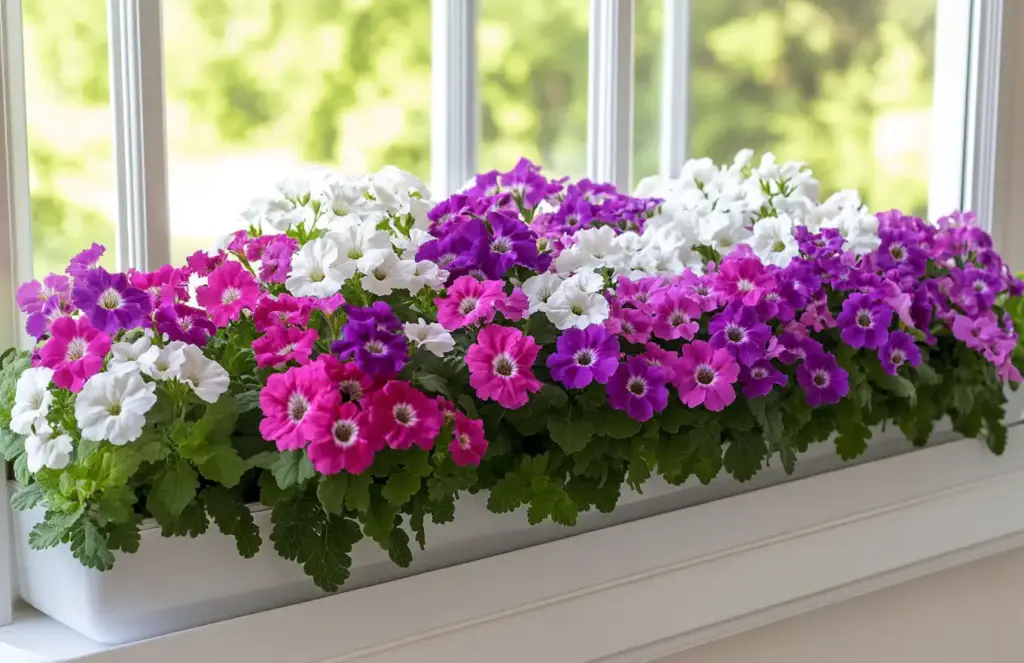
Verbena is a versatile and easy-to-grow drought tolerant plant that brings a pop of color to gardens with its clusters of small, five-petaled flowers. Native to America and Asia, Verbena is often grown as a perennial in warm climates and as an annual in cooler regions. Its resilience in dry conditions and ability to attract pollinators like bees and butterflies make it a garden favorite.
Growing Conditions:
- Soil: Prefers well-drained soil with a pH up to 8.0, making it adaptable to various garden settings.
- Location: Needs full sunlight for maximum bloom potential.
- Temperature: Can tolerate temperatures as low as 30-40°F.
- Plant Height: Typically grows between 1-2 feet tall.
- Colors: Blooms in red, pink, violet, and white, adding a splash of vibrant hues.
- Fertilizers: Thrives on all-purpose liquid fertilizers to keep blooms coming.
- Companion Plants: Pair with Shasta daisy, Chrysanthemum, and basil for a colorful, pollinator-friendly garden.
Verbena’s drought tolerance and ease of care make it perfect for borders, containers, and rock gardens, bringing continuous blooms throughout the growing season.
6. Lantana
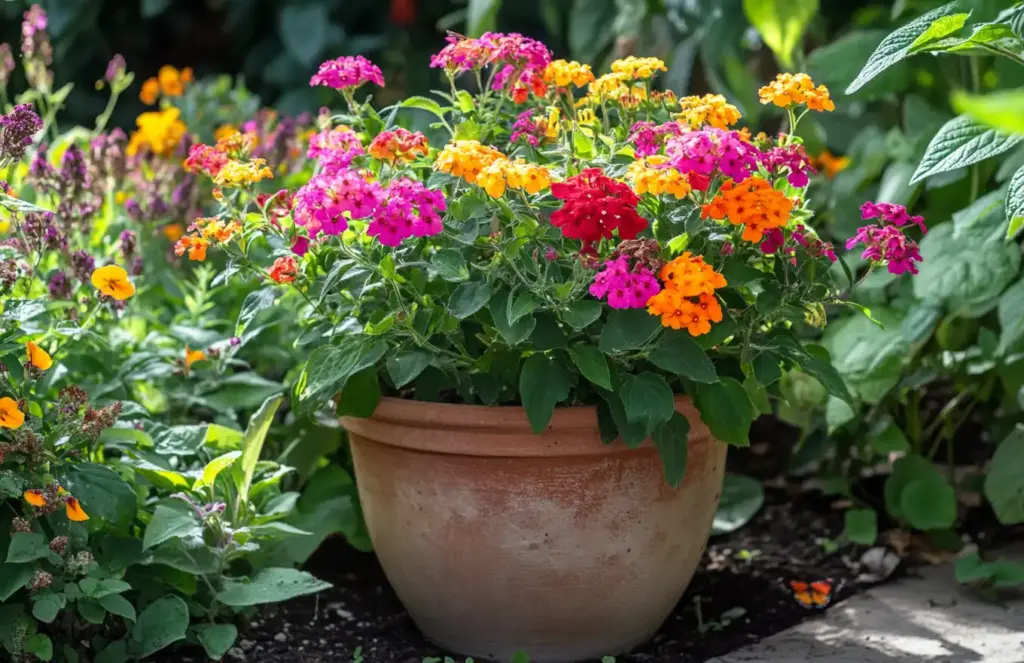
Lantana is a perennial flowering plant beloved for its bright, multi-colored flower clusters that attract butterflies, hummingbirds, and bees. Native to tropical regions of America and Africa, this hardy drought tolerant plant thrives in hot, dry conditions, making it a perfect choice for low-maintenance gardens and landscapes.
Growing Conditions:
- Soil: Prefers acidic, well-drained soil to promote healthy growth and flowering.
- Location: Full sunlight ensures abundant blooms.
- Temperature: Thrives in warm temperatures between 70-75°F.
- Plant Height: Typically grows between 2-6 feet tall, depending on variety and pruning.
- Colors: Showcases a vibrant mix of red, pink, yellow, white, and orange blooms.
- Fertilizers: Responds well to balanced N-P-K (10-10-10) fertilizers.
- Companion Plants: Pairs beautifully with butterfly bush and autumn sage for a pollinator-friendly garden.
Lantana’s heat and drought tolerance, combined with its stunning floral displays, make it a standout addition to any sun-drenched garden.
7. Erysimum
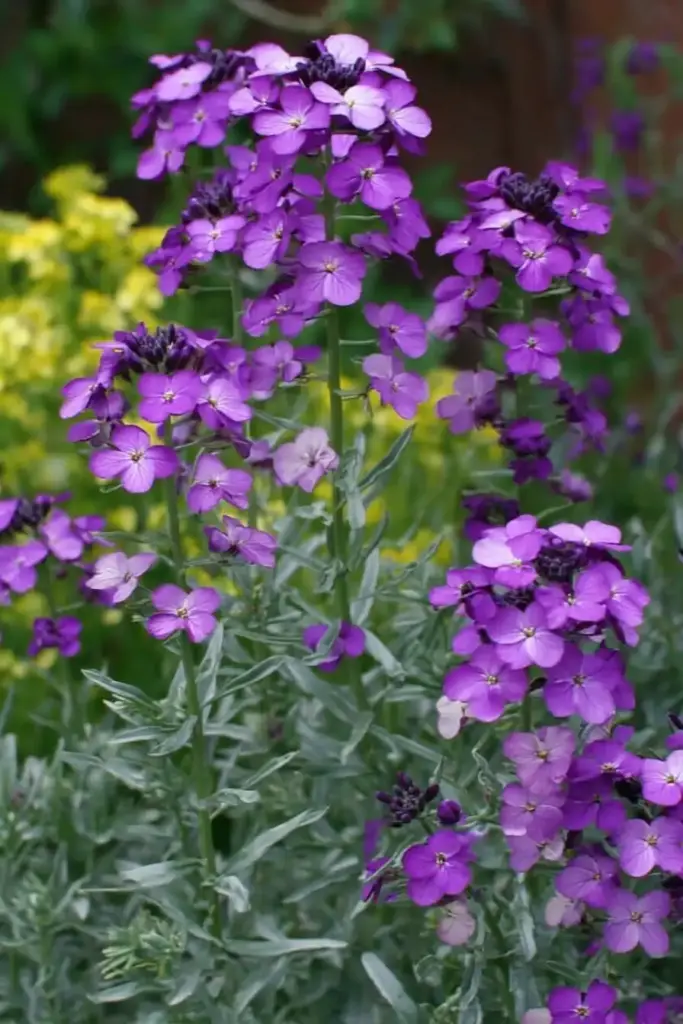
Erysimum, commonly known as wallflower, is a charming drought tolerant plant that brings a splash of color to gardens with its delicate, fragrant blooms. Known for its narrow, sessile leaves and clusters of small, bright flowers, Erysimum thrives in dry, sunny environments, making it a reliable choice for gardeners looking to add beauty to xeriscapes and rock gardens.
Growing Conditions:
- Soil: Prefers soil with a pH between 7.0 and 8.0, ensuring good drainage and root health.
- Location: Full sunlight promotes abundant flowering and healthy growth.
- Temperature: Thrives in moderate temperatures around 55-65°F.
- Plant Height: Grows between 1-2 feet tall, making it perfect for borders and mixed beds.
- Colors: Available in a delightful mix of pink, purple, blue, yellow, and orange hues.
- Fertilizers: Benefits from balanced N-P-K fertilizers to support continuous blooming.
- Companion Plants: Pairs well with spring bulbs, Alchemilla, and Tulipa for a seasonal garden display.
Erysimum’s ability to attract pollinators like bees, butterflies, and beetles, along with its drought resilience, makes it a versatile and rewarding addition to any garden.
8. Sage
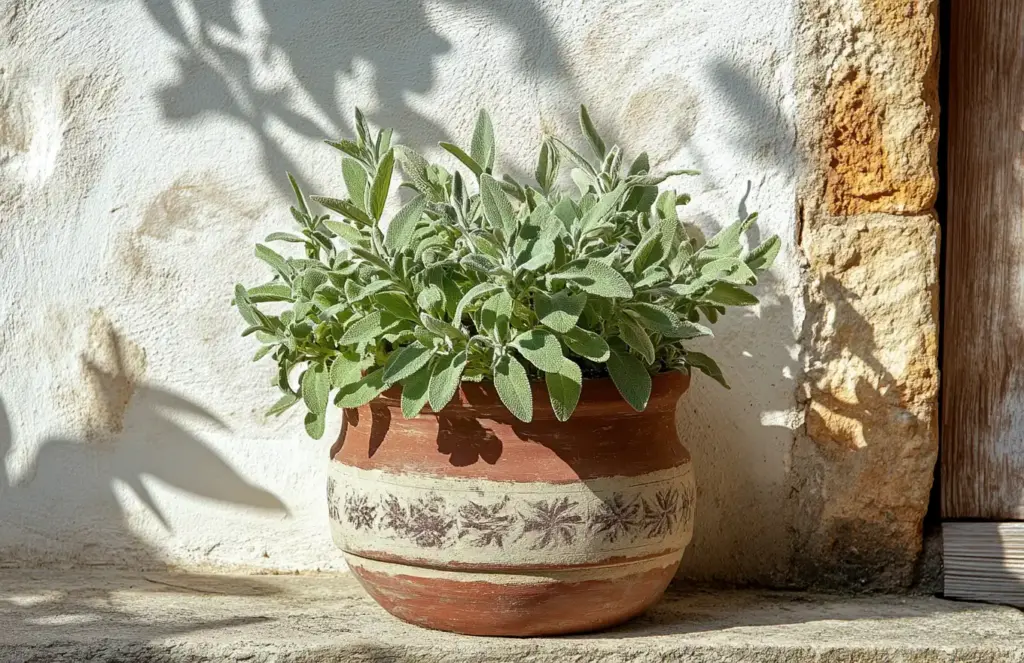
Sage, or Salvia officinalis, is a versatile drought tolerant plant known for its aromatic leaves and vibrant blooms. Native to the Mediterranean, this hardy perennial brings both culinary and ornamental value to gardens. Its grayish leaves, woody stems, and blue to purple flowers make it a standout in drought-prone landscapes.
Growing Conditions:
- Soil: Prefers sandy soil with a pH between 6.0 and 7.0, ensuring good drainage.
- Location: Needs full sunlight to thrive and develop its aromatic oils.
- Temperature: Best grown in mild temperatures between 60-70°F.
- Plant Height: Reaches 24-30 inches, suitable for herb gardens and borders.
- Colors: Green, white, and purple foliage adds texture and interest.
- Fertilizers: Low-nitrogen fertilizers help maintain flavor and prevent overly lush growth.
- Companion Plants: Complements cabbage, carrot, and rosemary in the garden, supporting biodiversity and pest control.
Sage’s drought tolerance and culinary uses make it a valuable addition to both edible and ornamental gardens.
9. Sedum
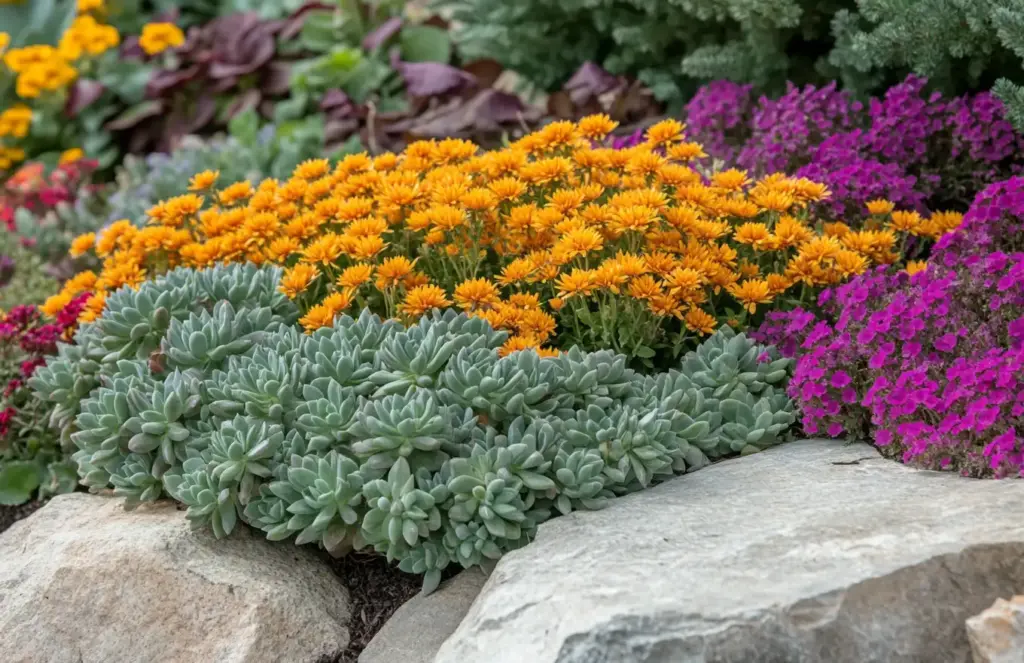
Sedum, also known as stonecrop, is a versatile and hardy drought tolerant plant found in gardens around the world. This leaf succulent is prized for its water-storing leaves and clusters of star-shaped flowers that add color to any landscape. With over 600 species available, Sedum offers gardeners a wide range of options for rock gardens, borders, and containers.
Growing Conditions:
- Soil: Thrives in soil with a pH between 6.0 and 7.5, offering excellent drainage.
- Location: Requires full sunlight to promote vibrant blooms and healthy foliage.
- Temperature: Grows best in temperatures between 65-75°F, but can handle both heat and drought well.
- Plant Height: Typically reaches up to 2 feet tall, depending on species and pruning.
- Colors: Blooms in a spectrum of purple, gold, pink, and yellow hues.
- Fertilizers: Benefits from compost or granular fertilizers to support healthy growth.
- Companion Plants: Pairs nicely with nasturtiums, ornamental grasses, and flowering cabbage for diverse textures and colors.
Sedum’s resilience and low water requirements make it a top choice for gardeners seeking an easy-care, drought tolerant plant that brings year-round interest.
10. Euphorbia
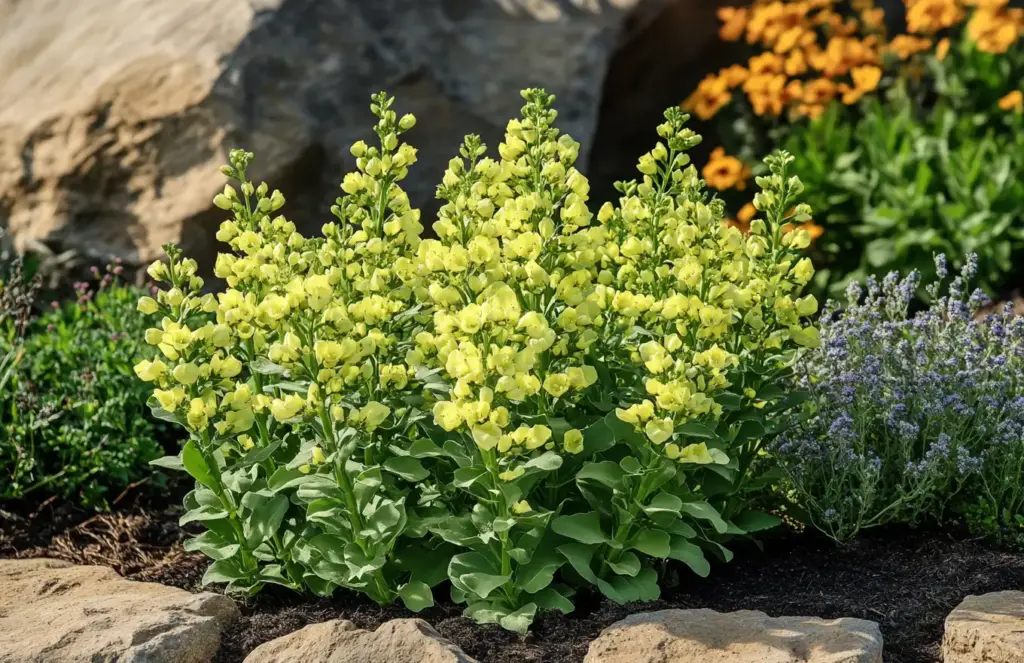
Euphorbia is a diverse genus of drought tolerant plants known for their unique floral structures and striking appearance. With species ranging from the crown of thorns to poinsettias, Euphorbia thrives in dry, hot conditions and is often used in landscaping for its resilience and distinctive beauty.
Growing Conditions:
- Soil: Prefers acidic, well-drained soil to support its fleshy stems and prevent root rot.
- Location: Needs full sunlight to thrive and maintain its vibrant appearance.
- Temperature: Tolerates temperatures between 30-40°F, withstanding occasional cold snaps.
- Plant Height: Can grow from 1 to 12 meters, depending on species and pruning.
- Colors: Blooms in shades of pink, yellow, white, and orange, adding a pop of color to dry gardens.
- Fertilizers: Benefits from low-nitrogen fertilizers that support healthy growth without encouraging excessive foliage.
- Companion Plants: Complements plants like Centranthus ruber, Rudbeckia hirta, and Nepeta, creating a diverse and low-maintenance garden design.
Euphorbia’s ability to store water in its thick stems allows it to survive extended dry spells, making it an excellent choice for water-wise gardens.
Conclusion
Incorporating drought tolerant plants into your garden is a smart, sustainable choice for anyone looking to create a beautiful and resilient landscape. From the vibrant blooms of bougainvillea and verbena to the striking structures of lithops and euphorbia, these hardy plants thrive with minimal water and maintenance. By selecting the right combination of these plants and pairing them with appropriate companion species, you can design a garden that not only withstands dry spells but also supports pollinators and enhances biodiversity.
For more gardening tips and inspiration, check out our guides on How to Grow Cilantro, Growing Peonies, and How to Grow Watermelon in Containers.
FAQ on Drought Tolerant Plants
1. What are drought tolerant plants?
Drought tolerant plants are species that can survive and thrive in conditions with minimal water. They often have adaptations like deep root systems, water-storing leaves or stems, and reduced leaf surface area to minimize water loss.
2. How do I care for drought tolerant plants?
Most drought tolerant plants prefer well-draining soil and full sunlight. Water them deeply but infrequently to encourage deep root growth, and use mulch to help retain moisture in the soil.
3. Can I grow drought tolerant plants in containers?
Yes! Many drought tolerant plants, such as sedum and portulaca, thrive in containers as long as they have good drainage and receive plenty of sunlight.
4. Are drought tolerant plants suitable for all climates?
While these plants excel in dry and hot climates, some species can also handle cooler temperatures and occasional frost. Check each plant’s growing conditions to find the best match for your region.
5. Do drought tolerant plants attract pollinators?
Absolutely! Many drought tolerant plants, including lantana, verbena, and blanket flower, are magnets for bees, butterflies, and hummingbirds.
6. How do I choose the best drought tolerant plants for my garden?
Consider your local climate, soil type, and sunlight availability. Start with easy-care options like bougainvillea or sage, then experiment with other varieties to diversify your garden

